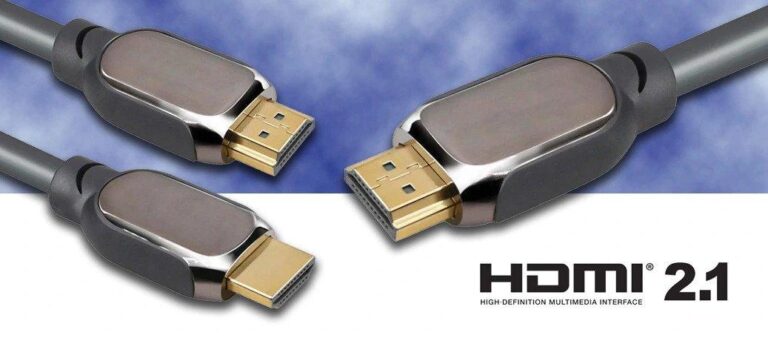In the world of technology, we often find ourselves keeping up with an ever-evolving landscape. One of the most critical aspects of this is the way we connect and transmit audio and video signals from our devices to our screens. HDMI (High-Definition Multimedia Interface) has been at the forefront of this technology, and with the introduction of HDMI 2.1 cable, it’s taking the game to a whole new level. In this blog, we’ll delve into the world of HDMI 2.1 and its significant role in the era of 8K resolution.
What is HDMI 2.1?
HDMI is a standard for transmitting audio and video data between devices like TVs, gaming consoles, Blu-ray players, and more. It’s the common interface that connects your home entertainment ecosystem. HDMI cable, as the latest iteration, introduces several key enhancements over its predecessors, HDMI 2.0 and HDMI 1.4.
Higher Bandwidth and Data Transfer Rates: HDMI 2.1 shines with notably higher bandwidth, granting speeds of up to 48 Gbps. This significant bandwidth increase is essential for managing the substantial data load needed for 8K resolution, along with advanced capabilities like dynamic HDR (High Dynamic Range) and elevated frame rates.
Enhanced Video and Audio Quality: HDMI 2.1 cable offers the possibility of enjoying breathtaking 8K video quality combined with dynamic HDR. This results in deeper blacks, brighter whites, and a broader spectrum of colours, ultimately creating a more realistic and immersive viewing experience. Additionally, HDMI 2.1 supports eARC (enhanced Audio Return Channel), which enables high-quality audio formats like Dolby Atmos and DTS:X.
Advanced Gaming Features: Gaming aficionados benefit greatly from HDMI 2.1. It brings advanced technologies such as Variable Refresh Rate (VRR) and Auto Low Latency Mode (ALLM), ensuring seamless interconnection between gaming consoles and screens to minimise delay, ultimately delivering a more fluid gaming experience. Additionally, HDMI 2.1 enables the adoption of elevated refresh rates, imparting a strikingly sleek and lifelike appearance to your gaming experience.
8K Resolution
As display tech advances, the demand for higher resolutions surges. Enter 8K, boasting about 7680 x 4320 pixels – four times 4K’s count. The perks of 8K are clear: sharper, detailed images and compatibility with bigger screens.
Benefits of 8K Resolution
Greater Details: 8K yields substantial advantages, offering superior image clarity and intricate detail, making it ideal for expansive screens. When viewing 8K content on a sizable display, you’ll observe more vibrant colours and an exceptional level of intricacy.
Ideal for Bigger Screens: 8K’s heightened resolution is particularly well-suited for larger screens. It enables you to sit in close proximity to the screen without compromising visual quality, ensuring an immersive cinematic experience right within your own living space.
Enhanced Viewing Enjoyment: The surplus pixels found in an 8K screen contribute to smoother visuals with diminished pixelation. This renders it perfect for various applications such as gaming and professional video editing.
HDMI 2.1 and 8K: A Perfect Match
So, how does HDMI 2.1 cables fit into the 8K equation? The answer lies in HDMI 2.1’s compatibility with the demanding requirements of 8K content.
HDMI 2.1 and 8K Resolution
Increased Bandwidth for 8K Content: The most significant contribution of HDMI 2.1 to the world of 8K is its higher bandwidth. HDMI 2.1’s 48 Gbps bandwidth easily manages 8K data, guaranteeing top-notch quality for your viewing pleasure.
Support for Higher Refresh Rates: HDMI 2.1 brings 8K clarity and boosts refresh rates to 120Hz and even 240Hz. This delivers smoother motion and reduces blur, elevating the entire viewing experience.
Compatibility with Existing 8K Devices and TVs: HDMI 2.1 is designed to be backward compatible with previous HDMI versions. This means you can use HDMI 2.1 cables and devices with your existing 8K TV or 4K displays, giving you room for future upgrades.
8K HDMI Cables
8K HDMI cables, purpose-built for HDMI 2.1, boost signal quality via enhanced shielding, bigger conductors, and superior insulation. This ensures a stable signal, enabling full 8K resolution enjoyment.
How to Choose the Right 8K HDMI Cable?
When selecting an 8K HDMI cable, consider the following:
Bandwidth Rating: Ensure that the cable is certified for 48 Gbps, which is the maximum bandwidth of HDMI 2.1. This rating guarantees that the cable can handle 8K content without any issues.
Cable Length: Longer cables can sometimes result in signal degradation. If you require a long cable, make sure it meets the necessary specifications for your setup.
Certifications: Look for cables that are HDMI 2.1 certified. This ensures that they meet the required standards for performance and compatibility.
Myth-Busting: Do You Really Need an Expensive Cable?
A common misconception exists regarding the necessity of splurging on a high-priced HDMI cable for the full benefits of HDMI 2.1 and 8K. The reality is that any cable meeting the requisite specifications can perform on par with a costlier alternative. HDMI 2.1 and 8K don’t discriminate based on cable cost; they rely on the cable’s ability to meet the necessary standards.
Conclusion
In the ever-evolving realm of technology, HDMI 2.1 and 8K mark a substantial advancement in our home entertainment experiences. HDMI 2.1’s greater bandwidth, improved video and audio quality, and advanced gaming attributes position it as a pivotal technology for the future. 8K resolution, with its intricate imagery and expansive displays, promises a very high level of immersion.
By choosing the appropriate 8K HDMI cables, you can fully unleash the potential of HDMI 2.1 and 8K without depleting your wallet. Enthusiastic gamers, particularly, can anticipate an extraordinary gaming encounter characterised by reduced input delay and seamless, high-refresh-rate gameplay.

